Integrated Reporting: A Critical Evaluation of Its Usefulness
VerifiedAdded on 2020/04/21
|11
|3505
|321
Report
AI Summary
This report provides a critical evaluation of integrated reporting, examining its usefulness in promoting corporate strategy by integrating financial and non-financial measures. The report focuses on the stakeholder perspective, particularly in South Africa, the first country to mandate integrated reporting on a wide scale. It explores the benefits of integrated reporting, such as improved information quality for investors and enhanced value creation, while also addressing challenges like limited guidance and investor reliance. The discussion covers the role of the International Integrated Reporting Council (IIRC), the influence of King Reports, and the evolution of integrated reporting practices across various sectors. The report also analyzes the relationship between integrated reporting and sustainability, the impact on equity capital cost, and the perspectives of different countries regarding its adoption. The report concludes by highlighting the potential of integrated reporting to enhance corporate reporting and improve stakeholder engagement, while also acknowledging the need for robust sustainability techniques and addressing concerns regarding its focus on investor value.
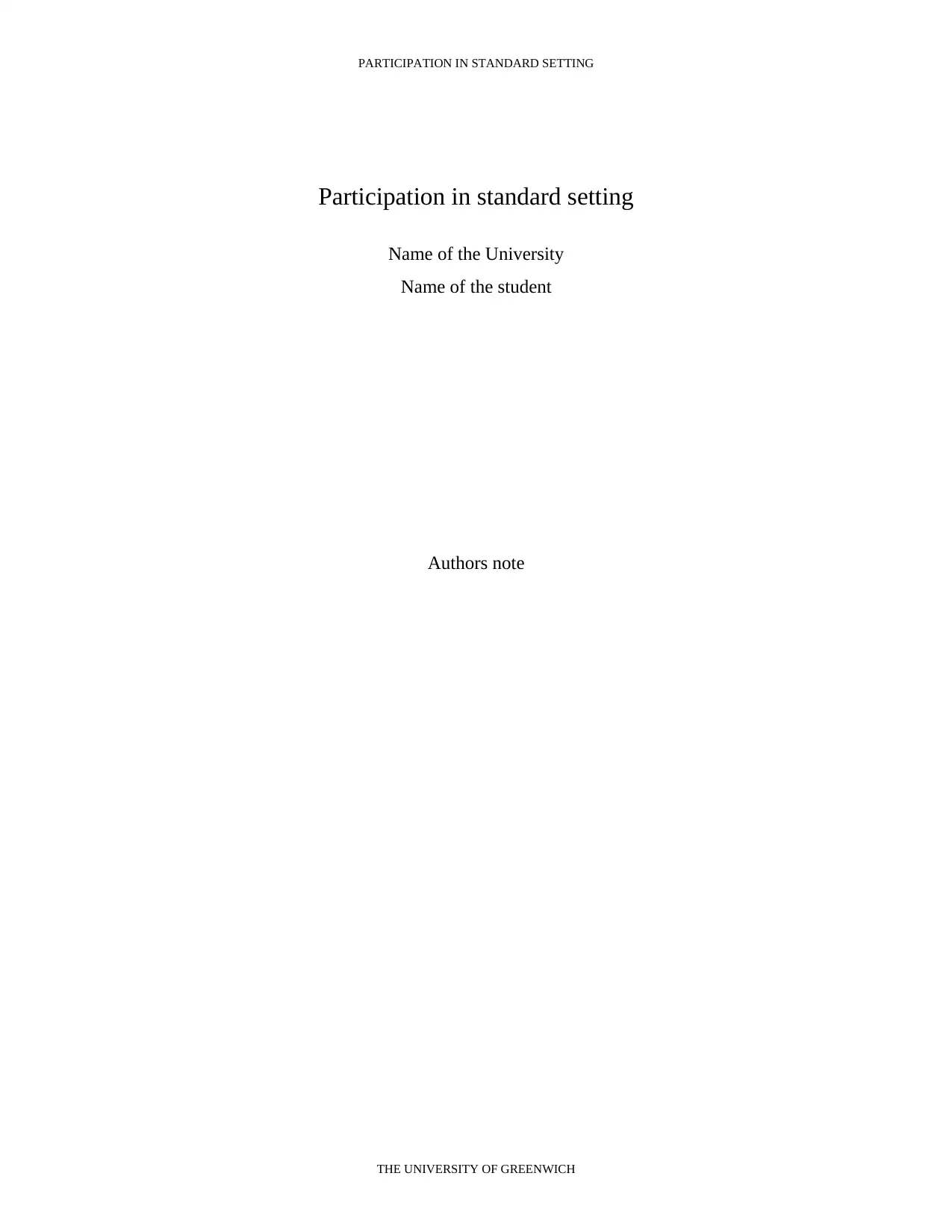
PARTICIPATION IN STANDARD SETTING
Participation in standard setting
Name of the University
Name of the student
Authors note
THE UNIVERSITY OF GREENWICH
Participation in standard setting
Name of the University
Name of the student
Authors note
THE UNIVERSITY OF GREENWICH
Paraphrase This Document
Need a fresh take? Get an instant paraphrase of this document with our AI Paraphraser
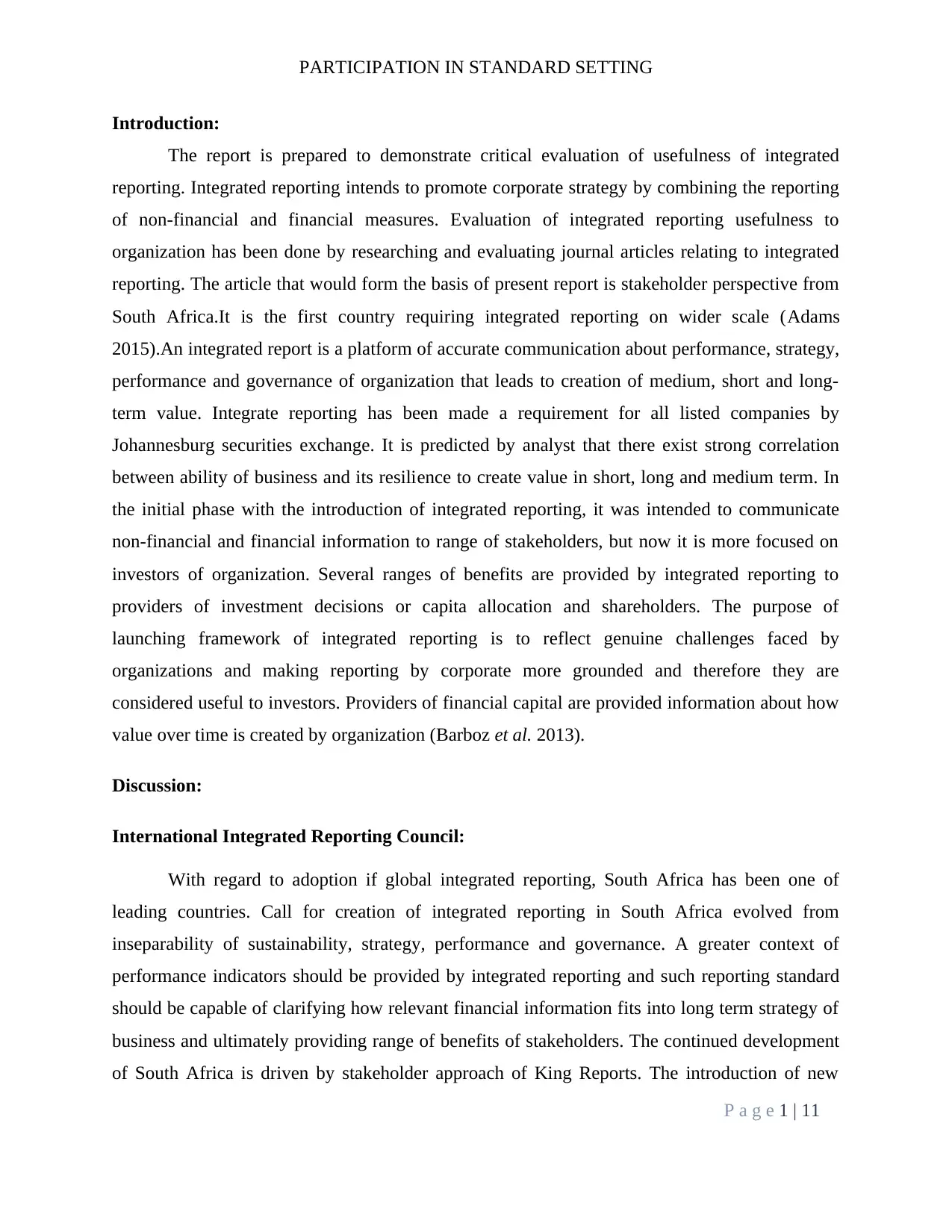
PARTICIPATION IN STANDARD SETTING
Introduction:
The report is prepared to demonstrate critical evaluation of usefulness of integrated
reporting. Integrated reporting intends to promote corporate strategy by combining the reporting
of non-financial and financial measures. Evaluation of integrated reporting usefulness to
organization has been done by researching and evaluating journal articles relating to integrated
reporting. The article that would form the basis of present report is stakeholder perspective from
South Africa.It is the first country requiring integrated reporting on wider scale (Adams
2015).An integrated report is a platform of accurate communication about performance, strategy,
performance and governance of organization that leads to creation of medium, short and long-
term value. Integrate reporting has been made a requirement for all listed companies by
Johannesburg securities exchange. It is predicted by analyst that there exist strong correlation
between ability of business and its resilience to create value in short, long and medium term. In
the initial phase with the introduction of integrated reporting, it was intended to communicate
non-financial and financial information to range of stakeholders, but now it is more focused on
investors of organization. Several ranges of benefits are provided by integrated reporting to
providers of investment decisions or capita allocation and shareholders. The purpose of
launching framework of integrated reporting is to reflect genuine challenges faced by
organizations and making reporting by corporate more grounded and therefore they are
considered useful to investors. Providers of financial capital are provided information about how
value over time is created by organization (Barboz et al. 2013).
Discussion:
International Integrated Reporting Council:
With regard to adoption if global integrated reporting, South Africa has been one of
leading countries. Call for creation of integrated reporting in South Africa evolved from
inseparability of sustainability, strategy, performance and governance. A greater context of
performance indicators should be provided by integrated reporting and such reporting standard
should be capable of clarifying how relevant financial information fits into long term strategy of
business and ultimately providing range of benefits of stakeholders. The continued development
of South Africa is driven by stakeholder approach of King Reports. The introduction of new
P a g e 1 | 11
Introduction:
The report is prepared to demonstrate critical evaluation of usefulness of integrated
reporting. Integrated reporting intends to promote corporate strategy by combining the reporting
of non-financial and financial measures. Evaluation of integrated reporting usefulness to
organization has been done by researching and evaluating journal articles relating to integrated
reporting. The article that would form the basis of present report is stakeholder perspective from
South Africa.It is the first country requiring integrated reporting on wider scale (Adams
2015).An integrated report is a platform of accurate communication about performance, strategy,
performance and governance of organization that leads to creation of medium, short and long-
term value. Integrate reporting has been made a requirement for all listed companies by
Johannesburg securities exchange. It is predicted by analyst that there exist strong correlation
between ability of business and its resilience to create value in short, long and medium term. In
the initial phase with the introduction of integrated reporting, it was intended to communicate
non-financial and financial information to range of stakeholders, but now it is more focused on
investors of organization. Several ranges of benefits are provided by integrated reporting to
providers of investment decisions or capita allocation and shareholders. The purpose of
launching framework of integrated reporting is to reflect genuine challenges faced by
organizations and making reporting by corporate more grounded and therefore they are
considered useful to investors. Providers of financial capital are provided information about how
value over time is created by organization (Barboz et al. 2013).
Discussion:
International Integrated Reporting Council:
With regard to adoption if global integrated reporting, South Africa has been one of
leading countries. Call for creation of integrated reporting in South Africa evolved from
inseparability of sustainability, strategy, performance and governance. A greater context of
performance indicators should be provided by integrated reporting and such reporting standard
should be capable of clarifying how relevant financial information fits into long term strategy of
business and ultimately providing range of benefits of stakeholders. The continued development
of South Africa is driven by stakeholder approach of King Reports. The introduction of new
P a g e 1 | 11
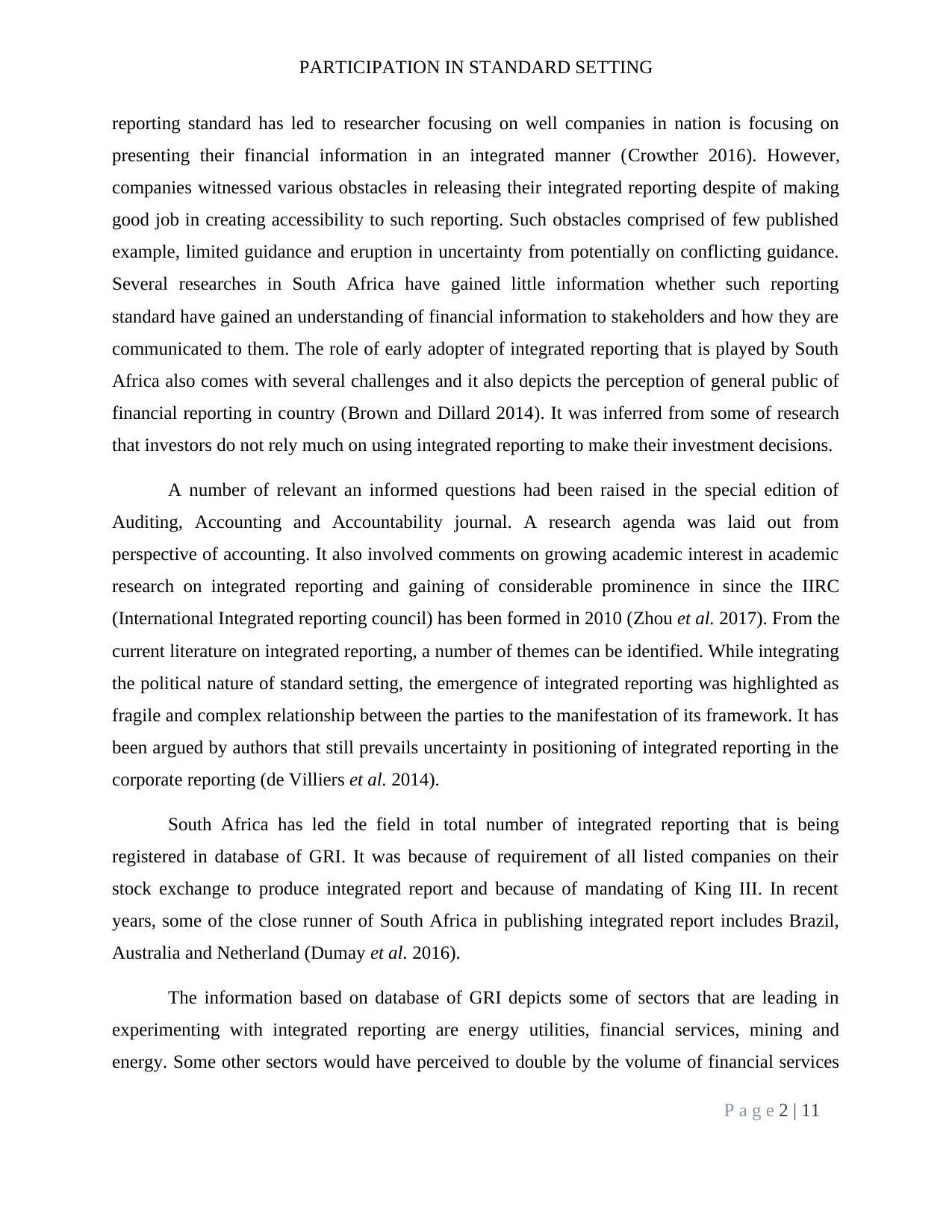
PARTICIPATION IN STANDARD SETTING
reporting standard has led to researcher focusing on well companies in nation is focusing on
presenting their financial information in an integrated manner (Crowther 2016). However,
companies witnessed various obstacles in releasing their integrated reporting despite of making
good job in creating accessibility to such reporting. Such obstacles comprised of few published
example, limited guidance and eruption in uncertainty from potentially on conflicting guidance.
Several researches in South Africa have gained little information whether such reporting
standard have gained an understanding of financial information to stakeholders and how they are
communicated to them. The role of early adopter of integrated reporting that is played by South
Africa also comes with several challenges and it also depicts the perception of general public of
financial reporting in country (Brown and Dillard 2014). It was inferred from some of research
that investors do not rely much on using integrated reporting to make their investment decisions.
A number of relevant an informed questions had been raised in the special edition of
Auditing, Accounting and Accountability journal. A research agenda was laid out from
perspective of accounting. It also involved comments on growing academic interest in academic
research on integrated reporting and gaining of considerable prominence in since the IIRC
(International Integrated reporting council) has been formed in 2010 (Zhou et al. 2017). From the
current literature on integrated reporting, a number of themes can be identified. While integrating
the political nature of standard setting, the emergence of integrated reporting was highlighted as
fragile and complex relationship between the parties to the manifestation of its framework. It has
been argued by authors that still prevails uncertainty in positioning of integrated reporting in the
corporate reporting (de Villiers et al. 2014).
South Africa has led the field in total number of integrated reporting that is being
registered in database of GRI. It was because of requirement of all listed companies on their
stock exchange to produce integrated report and because of mandating of King III. In recent
years, some of the close runner of South Africa in publishing integrated report includes Brazil,
Australia and Netherland (Dumay et al. 2016).
The information based on database of GRI depicts some of sectors that are leading in
experimenting with integrated reporting are energy utilities, financial services, mining and
energy. Some other sectors would have perceived to double by the volume of financial services
P a g e 2 | 11
reporting standard has led to researcher focusing on well companies in nation is focusing on
presenting their financial information in an integrated manner (Crowther 2016). However,
companies witnessed various obstacles in releasing their integrated reporting despite of making
good job in creating accessibility to such reporting. Such obstacles comprised of few published
example, limited guidance and eruption in uncertainty from potentially on conflicting guidance.
Several researches in South Africa have gained little information whether such reporting
standard have gained an understanding of financial information to stakeholders and how they are
communicated to them. The role of early adopter of integrated reporting that is played by South
Africa also comes with several challenges and it also depicts the perception of general public of
financial reporting in country (Brown and Dillard 2014). It was inferred from some of research
that investors do not rely much on using integrated reporting to make their investment decisions.
A number of relevant an informed questions had been raised in the special edition of
Auditing, Accounting and Accountability journal. A research agenda was laid out from
perspective of accounting. It also involved comments on growing academic interest in academic
research on integrated reporting and gaining of considerable prominence in since the IIRC
(International Integrated reporting council) has been formed in 2010 (Zhou et al. 2017). From the
current literature on integrated reporting, a number of themes can be identified. While integrating
the political nature of standard setting, the emergence of integrated reporting was highlighted as
fragile and complex relationship between the parties to the manifestation of its framework. It has
been argued by authors that still prevails uncertainty in positioning of integrated reporting in the
corporate reporting (de Villiers et al. 2014).
South Africa has led the field in total number of integrated reporting that is being
registered in database of GRI. It was because of requirement of all listed companies on their
stock exchange to produce integrated report and because of mandating of King III. In recent
years, some of the close runner of South Africa in publishing integrated report includes Brazil,
Australia and Netherland (Dumay et al. 2016).
The information based on database of GRI depicts some of sectors that are leading in
experimenting with integrated reporting are energy utilities, financial services, mining and
energy. Some other sectors would have perceived to double by the volume of financial services
P a g e 2 | 11
⊘ This is a preview!⊘
Do you want full access?
Subscribe today to unlock all pages.

Trusted by 1+ million students worldwide
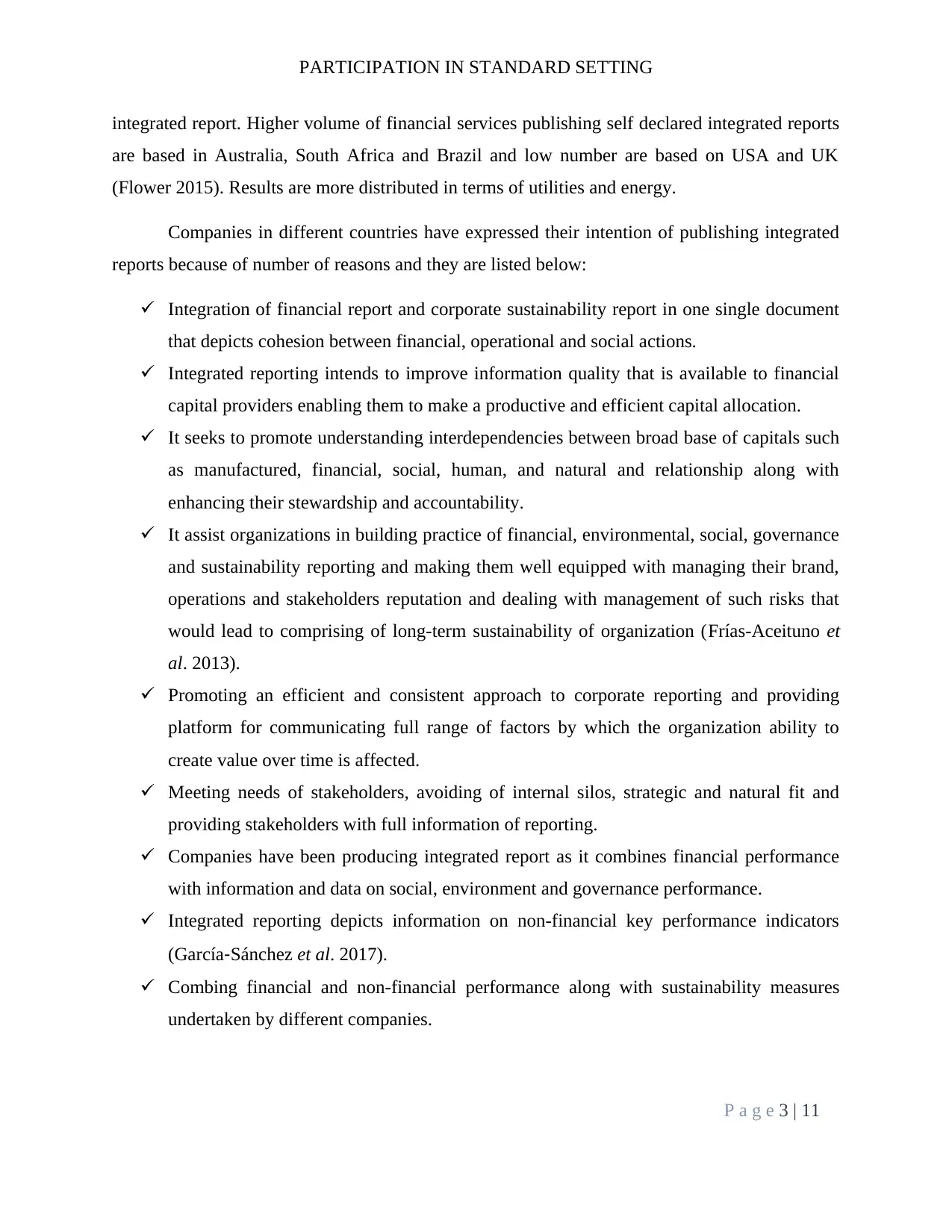
PARTICIPATION IN STANDARD SETTING
integrated report. Higher volume of financial services publishing self declared integrated reports
are based in Australia, South Africa and Brazil and low number are based on USA and UK
(Flower 2015). Results are more distributed in terms of utilities and energy.
Companies in different countries have expressed their intention of publishing integrated
reports because of number of reasons and they are listed below:
Integration of financial report and corporate sustainability report in one single document
that depicts cohesion between financial, operational and social actions.
Integrated reporting intends to improve information quality that is available to financial
capital providers enabling them to make a productive and efficient capital allocation.
It seeks to promote understanding interdependencies between broad base of capitals such
as manufactured, financial, social, human, and natural and relationship along with
enhancing their stewardship and accountability.
It assist organizations in building practice of financial, environmental, social, governance
and sustainability reporting and making them well equipped with managing their brand,
operations and stakeholders reputation and dealing with management of such risks that
would lead to comprising of long-term sustainability of organization (Frías-Aceituno et
al. 2013).
Promoting an efficient and consistent approach to corporate reporting and providing
platform for communicating full range of factors by which the organization ability to
create value over time is affected.
Meeting needs of stakeholders, avoiding of internal silos, strategic and natural fit and
providing stakeholders with full information of reporting.
Companies have been producing integrated report as it combines financial performance
with information and data on social, environment and governance performance.
Integrated reporting depicts information on non-financial key performance indicators
(García‐Sánchez et al. 2017).
Combing financial and non-financial performance along with sustainability measures
undertaken by different companies.
P a g e 3 | 11
integrated report. Higher volume of financial services publishing self declared integrated reports
are based in Australia, South Africa and Brazil and low number are based on USA and UK
(Flower 2015). Results are more distributed in terms of utilities and energy.
Companies in different countries have expressed their intention of publishing integrated
reports because of number of reasons and they are listed below:
Integration of financial report and corporate sustainability report in one single document
that depicts cohesion between financial, operational and social actions.
Integrated reporting intends to improve information quality that is available to financial
capital providers enabling them to make a productive and efficient capital allocation.
It seeks to promote understanding interdependencies between broad base of capitals such
as manufactured, financial, social, human, and natural and relationship along with
enhancing their stewardship and accountability.
It assist organizations in building practice of financial, environmental, social, governance
and sustainability reporting and making them well equipped with managing their brand,
operations and stakeholders reputation and dealing with management of such risks that
would lead to comprising of long-term sustainability of organization (Frías-Aceituno et
al. 2013).
Promoting an efficient and consistent approach to corporate reporting and providing
platform for communicating full range of factors by which the organization ability to
create value over time is affected.
Meeting needs of stakeholders, avoiding of internal silos, strategic and natural fit and
providing stakeholders with full information of reporting.
Companies have been producing integrated report as it combines financial performance
with information and data on social, environment and governance performance.
Integrated reporting depicts information on non-financial key performance indicators
(García‐Sánchez et al. 2017).
Combing financial and non-financial performance along with sustainability measures
undertaken by different companies.
P a g e 3 | 11
Paraphrase This Document
Need a fresh take? Get an instant paraphrase of this document with our AI Paraphraser
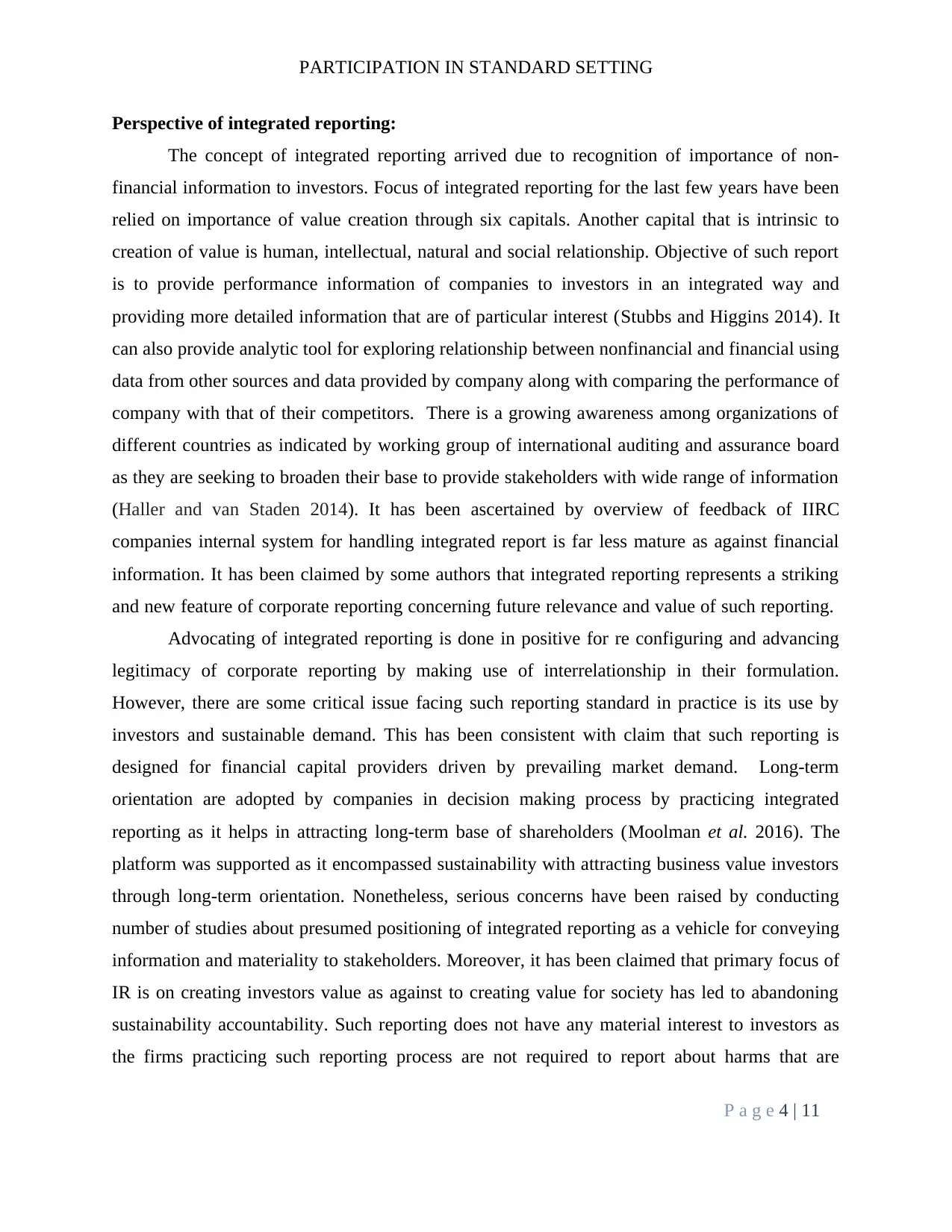
PARTICIPATION IN STANDARD SETTING
Perspective of integrated reporting:
The concept of integrated reporting arrived due to recognition of importance of non-
financial information to investors. Focus of integrated reporting for the last few years have been
relied on importance of value creation through six capitals. Another capital that is intrinsic to
creation of value is human, intellectual, natural and social relationship. Objective of such report
is to provide performance information of companies to investors in an integrated way and
providing more detailed information that are of particular interest (Stubbs and Higgins 2014). It
can also provide analytic tool for exploring relationship between nonfinancial and financial using
data from other sources and data provided by company along with comparing the performance of
company with that of their competitors. There is a growing awareness among organizations of
different countries as indicated by working group of international auditing and assurance board
as they are seeking to broaden their base to provide stakeholders with wide range of information
(Haller and van Staden 2014). It has been ascertained by overview of feedback of IIRC
companies internal system for handling integrated report is far less mature as against financial
information. It has been claimed by some authors that integrated reporting represents a striking
and new feature of corporate reporting concerning future relevance and value of such reporting.
Advocating of integrated reporting is done in positive for re configuring and advancing
legitimacy of corporate reporting by making use of interrelationship in their formulation.
However, there are some critical issue facing such reporting standard in practice is its use by
investors and sustainable demand. This has been consistent with claim that such reporting is
designed for financial capital providers driven by prevailing market demand. Long-term
orientation are adopted by companies in decision making process by practicing integrated
reporting as it helps in attracting long-term base of shareholders (Moolman et al. 2016). The
platform was supported as it encompassed sustainability with attracting business value investors
through long-term orientation. Nonetheless, serious concerns have been raised by conducting
number of studies about presumed positioning of integrated reporting as a vehicle for conveying
information and materiality to stakeholders. Moreover, it has been claimed that primary focus of
IR is on creating investors value as against to creating value for society has led to abandoning
sustainability accountability. Such reporting does not have any material interest to investors as
the firms practicing such reporting process are not required to report about harms that are
P a g e 4 | 11
Perspective of integrated reporting:
The concept of integrated reporting arrived due to recognition of importance of non-
financial information to investors. Focus of integrated reporting for the last few years have been
relied on importance of value creation through six capitals. Another capital that is intrinsic to
creation of value is human, intellectual, natural and social relationship. Objective of such report
is to provide performance information of companies to investors in an integrated way and
providing more detailed information that are of particular interest (Stubbs and Higgins 2014). It
can also provide analytic tool for exploring relationship between nonfinancial and financial using
data from other sources and data provided by company along with comparing the performance of
company with that of their competitors. There is a growing awareness among organizations of
different countries as indicated by working group of international auditing and assurance board
as they are seeking to broaden their base to provide stakeholders with wide range of information
(Haller and van Staden 2014). It has been ascertained by overview of feedback of IIRC
companies internal system for handling integrated report is far less mature as against financial
information. It has been claimed by some authors that integrated reporting represents a striking
and new feature of corporate reporting concerning future relevance and value of such reporting.
Advocating of integrated reporting is done in positive for re configuring and advancing
legitimacy of corporate reporting by making use of interrelationship in their formulation.
However, there are some critical issue facing such reporting standard in practice is its use by
investors and sustainable demand. This has been consistent with claim that such reporting is
designed for financial capital providers driven by prevailing market demand. Long-term
orientation are adopted by companies in decision making process by practicing integrated
reporting as it helps in attracting long-term base of shareholders (Moolman et al. 2016). The
platform was supported as it encompassed sustainability with attracting business value investors
through long-term orientation. Nonetheless, serious concerns have been raised by conducting
number of studies about presumed positioning of integrated reporting as a vehicle for conveying
information and materiality to stakeholders. Moreover, it has been claimed that primary focus of
IR is on creating investors value as against to creating value for society has led to abandoning
sustainability accountability. Such reporting does not have any material interest to investors as
the firms practicing such reporting process are not required to report about harms that are
P a g e 4 | 11
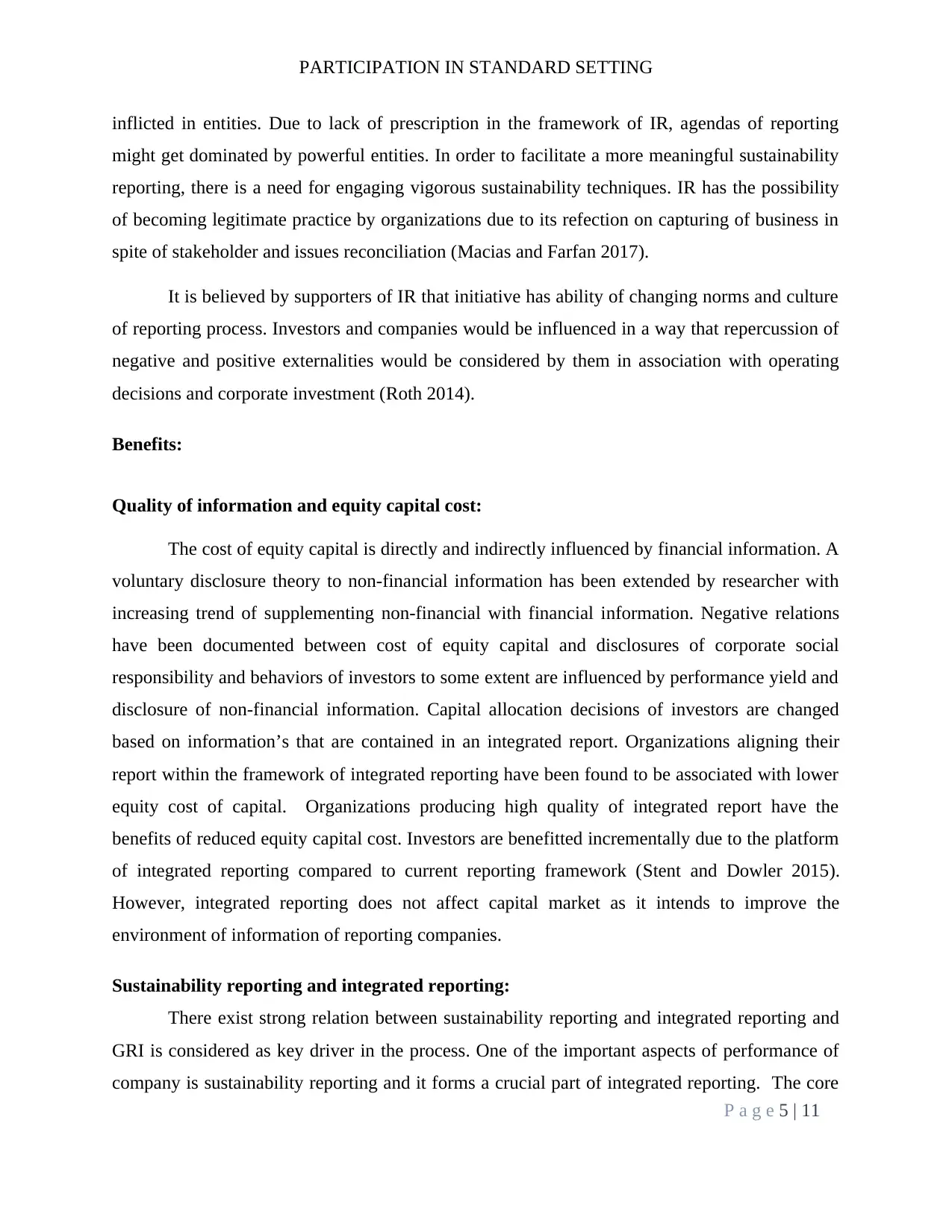
PARTICIPATION IN STANDARD SETTING
inflicted in entities. Due to lack of prescription in the framework of IR, agendas of reporting
might get dominated by powerful entities. In order to facilitate a more meaningful sustainability
reporting, there is a need for engaging vigorous sustainability techniques. IR has the possibility
of becoming legitimate practice by organizations due to its refection on capturing of business in
spite of stakeholder and issues reconciliation (Macias and Farfan 2017).
It is believed by supporters of IR that initiative has ability of changing norms and culture
of reporting process. Investors and companies would be influenced in a way that repercussion of
negative and positive externalities would be considered by them in association with operating
decisions and corporate investment (Roth 2014).
Benefits:
Quality of information and equity capital cost:
The cost of equity capital is directly and indirectly influenced by financial information. A
voluntary disclosure theory to non-financial information has been extended by researcher with
increasing trend of supplementing non-financial with financial information. Negative relations
have been documented between cost of equity capital and disclosures of corporate social
responsibility and behaviors of investors to some extent are influenced by performance yield and
disclosure of non-financial information. Capital allocation decisions of investors are changed
based on information’s that are contained in an integrated report. Organizations aligning their
report within the framework of integrated reporting have been found to be associated with lower
equity cost of capital. Organizations producing high quality of integrated report have the
benefits of reduced equity capital cost. Investors are benefitted incrementally due to the platform
of integrated reporting compared to current reporting framework (Stent and Dowler 2015).
However, integrated reporting does not affect capital market as it intends to improve the
environment of information of reporting companies.
Sustainability reporting and integrated reporting:
There exist strong relation between sustainability reporting and integrated reporting and
GRI is considered as key driver in the process. One of the important aspects of performance of
company is sustainability reporting and it forms a crucial part of integrated reporting. The core
P a g e 5 | 11
inflicted in entities. Due to lack of prescription in the framework of IR, agendas of reporting
might get dominated by powerful entities. In order to facilitate a more meaningful sustainability
reporting, there is a need for engaging vigorous sustainability techniques. IR has the possibility
of becoming legitimate practice by organizations due to its refection on capturing of business in
spite of stakeholder and issues reconciliation (Macias and Farfan 2017).
It is believed by supporters of IR that initiative has ability of changing norms and culture
of reporting process. Investors and companies would be influenced in a way that repercussion of
negative and positive externalities would be considered by them in association with operating
decisions and corporate investment (Roth 2014).
Benefits:
Quality of information and equity capital cost:
The cost of equity capital is directly and indirectly influenced by financial information. A
voluntary disclosure theory to non-financial information has been extended by researcher with
increasing trend of supplementing non-financial with financial information. Negative relations
have been documented between cost of equity capital and disclosures of corporate social
responsibility and behaviors of investors to some extent are influenced by performance yield and
disclosure of non-financial information. Capital allocation decisions of investors are changed
based on information’s that are contained in an integrated report. Organizations aligning their
report within the framework of integrated reporting have been found to be associated with lower
equity cost of capital. Organizations producing high quality of integrated report have the
benefits of reduced equity capital cost. Investors are benefitted incrementally due to the platform
of integrated reporting compared to current reporting framework (Stent and Dowler 2015).
However, integrated reporting does not affect capital market as it intends to improve the
environment of information of reporting companies.
Sustainability reporting and integrated reporting:
There exist strong relation between sustainability reporting and integrated reporting and
GRI is considered as key driver in the process. One of the important aspects of performance of
company is sustainability reporting and it forms a crucial part of integrated reporting. The core
P a g e 5 | 11
⊘ This is a preview!⊘
Do you want full access?
Subscribe today to unlock all pages.

Trusted by 1+ million students worldwide
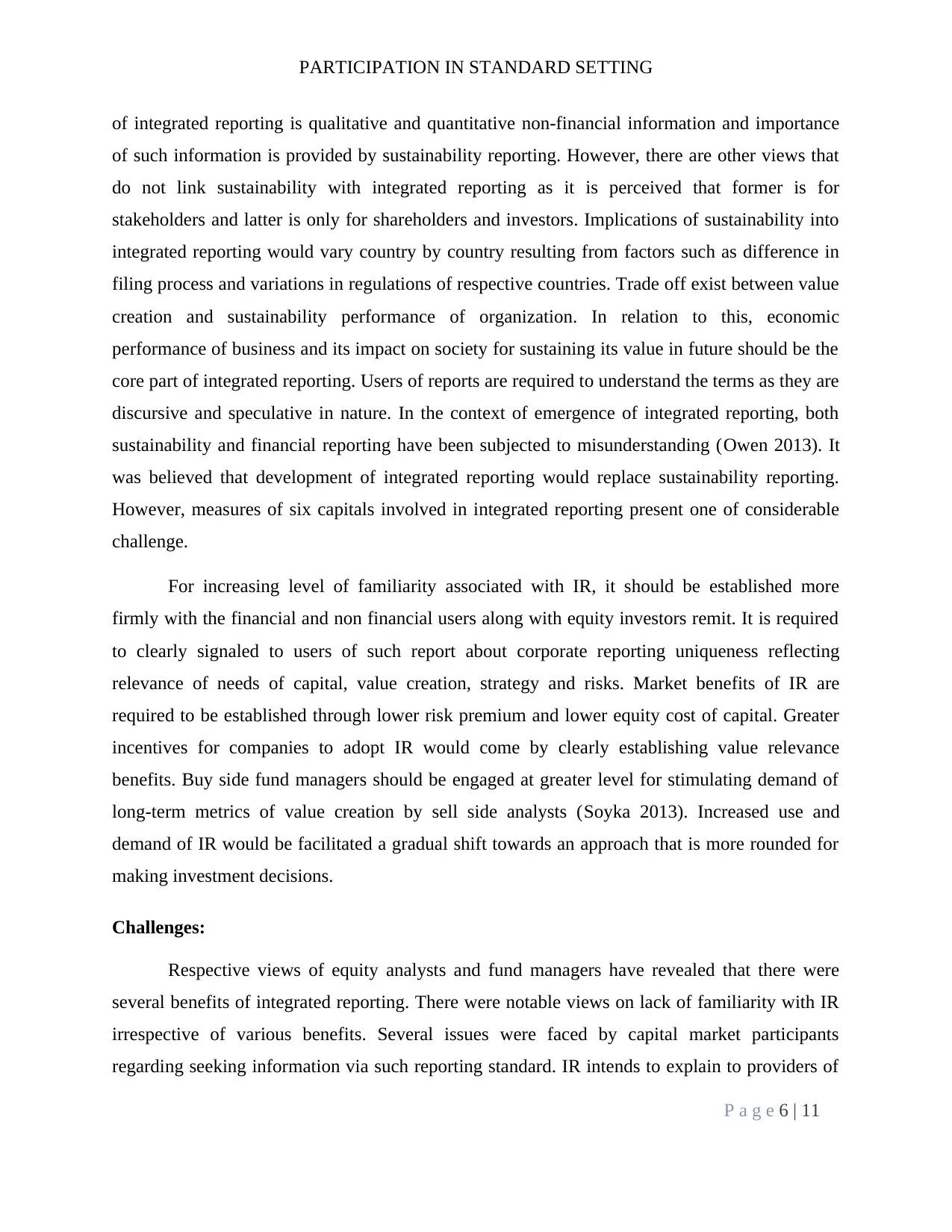
PARTICIPATION IN STANDARD SETTING
of integrated reporting is qualitative and quantitative non-financial information and importance
of such information is provided by sustainability reporting. However, there are other views that
do not link sustainability with integrated reporting as it is perceived that former is for
stakeholders and latter is only for shareholders and investors. Implications of sustainability into
integrated reporting would vary country by country resulting from factors such as difference in
filing process and variations in regulations of respective countries. Trade off exist between value
creation and sustainability performance of organization. In relation to this, economic
performance of business and its impact on society for sustaining its value in future should be the
core part of integrated reporting. Users of reports are required to understand the terms as they are
discursive and speculative in nature. In the context of emergence of integrated reporting, both
sustainability and financial reporting have been subjected to misunderstanding (Owen 2013). It
was believed that development of integrated reporting would replace sustainability reporting.
However, measures of six capitals involved in integrated reporting present one of considerable
challenge.
For increasing level of familiarity associated with IR, it should be established more
firmly with the financial and non financial users along with equity investors remit. It is required
to clearly signaled to users of such report about corporate reporting uniqueness reflecting
relevance of needs of capital, value creation, strategy and risks. Market benefits of IR are
required to be established through lower risk premium and lower equity cost of capital. Greater
incentives for companies to adopt IR would come by clearly establishing value relevance
benefits. Buy side fund managers should be engaged at greater level for stimulating demand of
long-term metrics of value creation by sell side analysts (Soyka 2013). Increased use and
demand of IR would be facilitated a gradual shift towards an approach that is more rounded for
making investment decisions.
Challenges:
Respective views of equity analysts and fund managers have revealed that there were
several benefits of integrated reporting. There were notable views on lack of familiarity with IR
irrespective of various benefits. Several issues were faced by capital market participants
regarding seeking information via such reporting standard. IR intends to explain to providers of
P a g e 6 | 11
of integrated reporting is qualitative and quantitative non-financial information and importance
of such information is provided by sustainability reporting. However, there are other views that
do not link sustainability with integrated reporting as it is perceived that former is for
stakeholders and latter is only for shareholders and investors. Implications of sustainability into
integrated reporting would vary country by country resulting from factors such as difference in
filing process and variations in regulations of respective countries. Trade off exist between value
creation and sustainability performance of organization. In relation to this, economic
performance of business and its impact on society for sustaining its value in future should be the
core part of integrated reporting. Users of reports are required to understand the terms as they are
discursive and speculative in nature. In the context of emergence of integrated reporting, both
sustainability and financial reporting have been subjected to misunderstanding (Owen 2013). It
was believed that development of integrated reporting would replace sustainability reporting.
However, measures of six capitals involved in integrated reporting present one of considerable
challenge.
For increasing level of familiarity associated with IR, it should be established more
firmly with the financial and non financial users along with equity investors remit. It is required
to clearly signaled to users of such report about corporate reporting uniqueness reflecting
relevance of needs of capital, value creation, strategy and risks. Market benefits of IR are
required to be established through lower risk premium and lower equity cost of capital. Greater
incentives for companies to adopt IR would come by clearly establishing value relevance
benefits. Buy side fund managers should be engaged at greater level for stimulating demand of
long-term metrics of value creation by sell side analysts (Soyka 2013). Increased use and
demand of IR would be facilitated a gradual shift towards an approach that is more rounded for
making investment decisions.
Challenges:
Respective views of equity analysts and fund managers have revealed that there were
several benefits of integrated reporting. There were notable views on lack of familiarity with IR
irrespective of various benefits. Several issues were faced by capital market participants
regarding seeking information via such reporting standard. IR intends to explain to providers of
P a g e 6 | 11
Paraphrase This Document
Need a fresh take? Get an instant paraphrase of this document with our AI Paraphraser
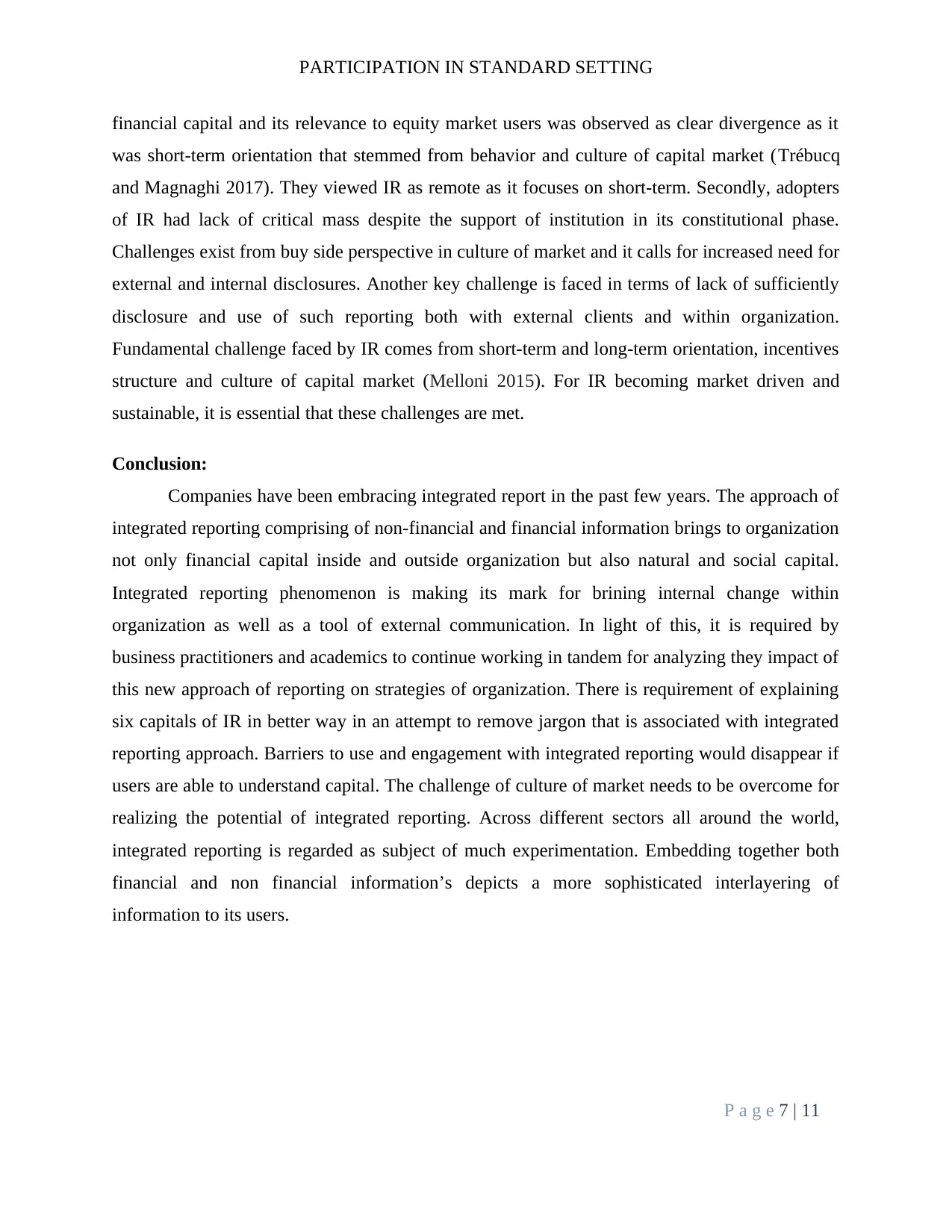
PARTICIPATION IN STANDARD SETTING
financial capital and its relevance to equity market users was observed as clear divergence as it
was short-term orientation that stemmed from behavior and culture of capital market (Trébucq
and Magnaghi 2017). They viewed IR as remote as it focuses on short-term. Secondly, adopters
of IR had lack of critical mass despite the support of institution in its constitutional phase.
Challenges exist from buy side perspective in culture of market and it calls for increased need for
external and internal disclosures. Another key challenge is faced in terms of lack of sufficiently
disclosure and use of such reporting both with external clients and within organization.
Fundamental challenge faced by IR comes from short-term and long-term orientation, incentives
structure and culture of capital market (Melloni 2015). For IR becoming market driven and
sustainable, it is essential that these challenges are met.
Conclusion:
Companies have been embracing integrated report in the past few years. The approach of
integrated reporting comprising of non-financial and financial information brings to organization
not only financial capital inside and outside organization but also natural and social capital.
Integrated reporting phenomenon is making its mark for brining internal change within
organization as well as a tool of external communication. In light of this, it is required by
business practitioners and academics to continue working in tandem for analyzing they impact of
this new approach of reporting on strategies of organization. There is requirement of explaining
six capitals of IR in better way in an attempt to remove jargon that is associated with integrated
reporting approach. Barriers to use and engagement with integrated reporting would disappear if
users are able to understand capital. The challenge of culture of market needs to be overcome for
realizing the potential of integrated reporting. Across different sectors all around the world,
integrated reporting is regarded as subject of much experimentation. Embedding together both
financial and non financial information’s depicts a more sophisticated interlayering of
information to its users.
P a g e 7 | 11
financial capital and its relevance to equity market users was observed as clear divergence as it
was short-term orientation that stemmed from behavior and culture of capital market (Trébucq
and Magnaghi 2017). They viewed IR as remote as it focuses on short-term. Secondly, adopters
of IR had lack of critical mass despite the support of institution in its constitutional phase.
Challenges exist from buy side perspective in culture of market and it calls for increased need for
external and internal disclosures. Another key challenge is faced in terms of lack of sufficiently
disclosure and use of such reporting both with external clients and within organization.
Fundamental challenge faced by IR comes from short-term and long-term orientation, incentives
structure and culture of capital market (Melloni 2015). For IR becoming market driven and
sustainable, it is essential that these challenges are met.
Conclusion:
Companies have been embracing integrated report in the past few years. The approach of
integrated reporting comprising of non-financial and financial information brings to organization
not only financial capital inside and outside organization but also natural and social capital.
Integrated reporting phenomenon is making its mark for brining internal change within
organization as well as a tool of external communication. In light of this, it is required by
business practitioners and academics to continue working in tandem for analyzing they impact of
this new approach of reporting on strategies of organization. There is requirement of explaining
six capitals of IR in better way in an attempt to remove jargon that is associated with integrated
reporting approach. Barriers to use and engagement with integrated reporting would disappear if
users are able to understand capital. The challenge of culture of market needs to be overcome for
realizing the potential of integrated reporting. Across different sectors all around the world,
integrated reporting is regarded as subject of much experimentation. Embedding together both
financial and non financial information’s depicts a more sophisticated interlayering of
information to its users.
P a g e 7 | 11
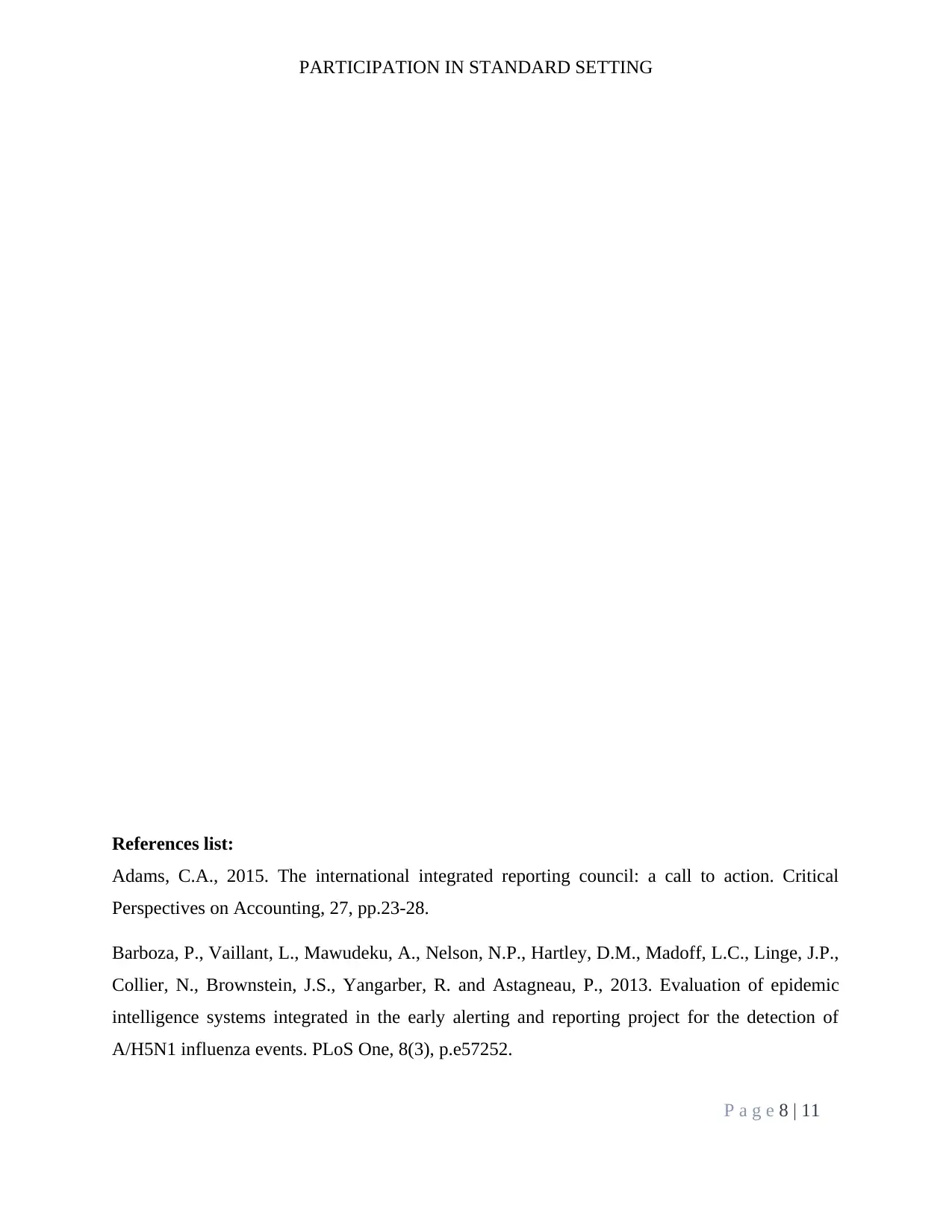
PARTICIPATION IN STANDARD SETTING
References list:
Adams, C.A., 2015. The international integrated reporting council: a call to action. Critical
Perspectives on Accounting, 27, pp.23-28.
Barboza, P., Vaillant, L., Mawudeku, A., Nelson, N.P., Hartley, D.M., Madoff, L.C., Linge, J.P.,
Collier, N., Brownstein, J.S., Yangarber, R. and Astagneau, P., 2013. Evaluation of epidemic
intelligence systems integrated in the early alerting and reporting project for the detection of
A/H5N1 influenza events. PLoS One, 8(3), p.e57252.
P a g e 8 | 11
References list:
Adams, C.A., 2015. The international integrated reporting council: a call to action. Critical
Perspectives on Accounting, 27, pp.23-28.
Barboza, P., Vaillant, L., Mawudeku, A., Nelson, N.P., Hartley, D.M., Madoff, L.C., Linge, J.P.,
Collier, N., Brownstein, J.S., Yangarber, R. and Astagneau, P., 2013. Evaluation of epidemic
intelligence systems integrated in the early alerting and reporting project for the detection of
A/H5N1 influenza events. PLoS One, 8(3), p.e57252.
P a g e 8 | 11
⊘ This is a preview!⊘
Do you want full access?
Subscribe today to unlock all pages.

Trusted by 1+ million students worldwide
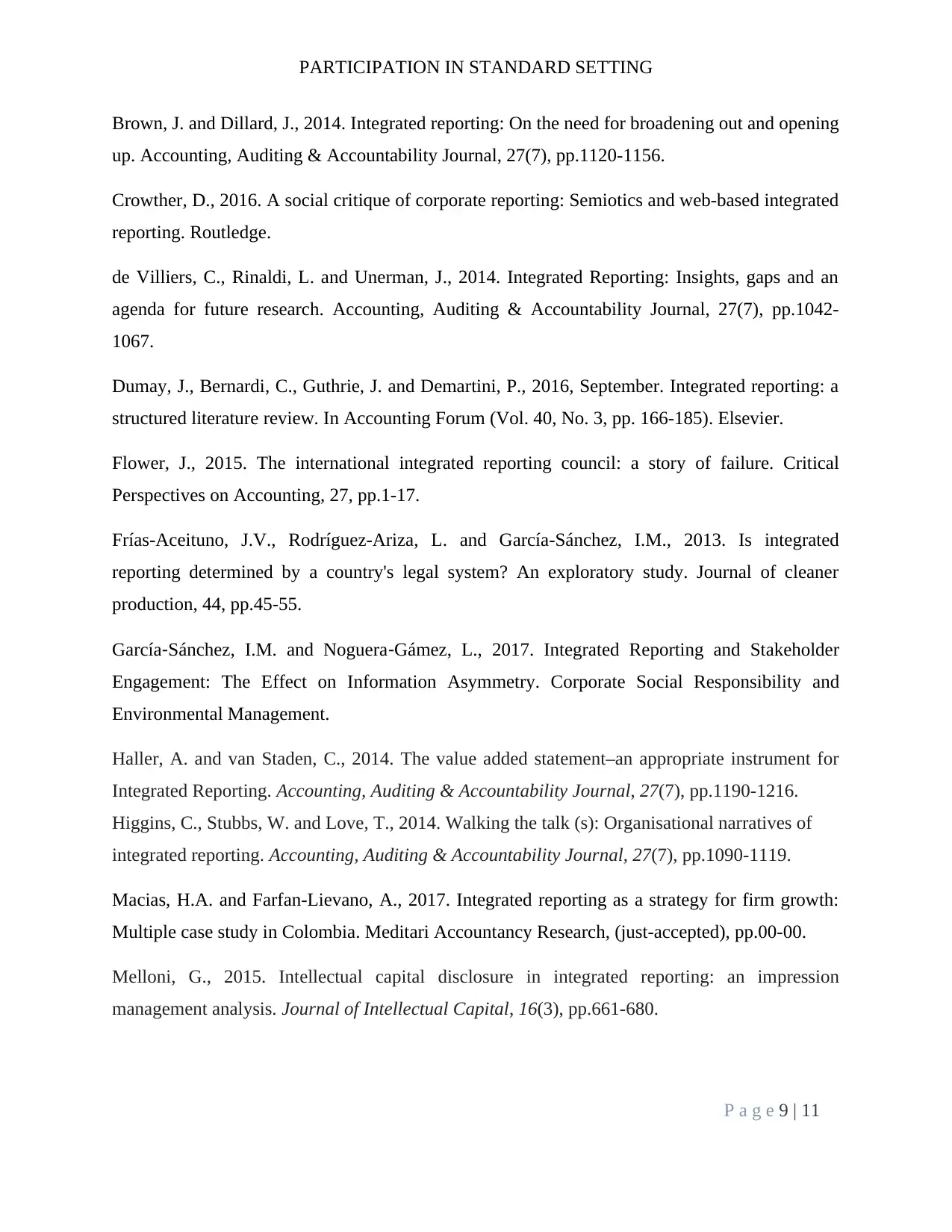
PARTICIPATION IN STANDARD SETTING
Brown, J. and Dillard, J., 2014. Integrated reporting: On the need for broadening out and opening
up. Accounting, Auditing & Accountability Journal, 27(7), pp.1120-1156.
Crowther, D., 2016. A social critique of corporate reporting: Semiotics and web-based integrated
reporting. Routledge.
de Villiers, C., Rinaldi, L. and Unerman, J., 2014. Integrated Reporting: Insights, gaps and an
agenda for future research. Accounting, Auditing & Accountability Journal, 27(7), pp.1042-
1067.
Dumay, J., Bernardi, C., Guthrie, J. and Demartini, P., 2016, September. Integrated reporting: a
structured literature review. In Accounting Forum (Vol. 40, No. 3, pp. 166-185). Elsevier.
Flower, J., 2015. The international integrated reporting council: a story of failure. Critical
Perspectives on Accounting, 27, pp.1-17.
Frías-Aceituno, J.V., Rodríguez-Ariza, L. and García-Sánchez, I.M., 2013. Is integrated
reporting determined by a country's legal system? An exploratory study. Journal of cleaner
production, 44, pp.45-55.
García‐Sánchez, I.M. and Noguera‐Gámez, L., 2017. Integrated Reporting and Stakeholder
Engagement: The Effect on Information Asymmetry. Corporate Social Responsibility and
Environmental Management.
Haller, A. and van Staden, C., 2014. The value added statement–an appropriate instrument for
Integrated Reporting. Accounting, Auditing & Accountability Journal, 27(7), pp.1190-1216.
Higgins, C., Stubbs, W. and Love, T., 2014. Walking the talk (s): Organisational narratives of
integrated reporting. Accounting, Auditing & Accountability Journal, 27(7), pp.1090-1119.
Macias, H.A. and Farfan-Lievano, A., 2017. Integrated reporting as a strategy for firm growth:
Multiple case study in Colombia. Meditari Accountancy Research, (just-accepted), pp.00-00.
Melloni, G., 2015. Intellectual capital disclosure in integrated reporting: an impression
management analysis. Journal of Intellectual Capital, 16(3), pp.661-680.
P a g e 9 | 11
Brown, J. and Dillard, J., 2014. Integrated reporting: On the need for broadening out and opening
up. Accounting, Auditing & Accountability Journal, 27(7), pp.1120-1156.
Crowther, D., 2016. A social critique of corporate reporting: Semiotics and web-based integrated
reporting. Routledge.
de Villiers, C., Rinaldi, L. and Unerman, J., 2014. Integrated Reporting: Insights, gaps and an
agenda for future research. Accounting, Auditing & Accountability Journal, 27(7), pp.1042-
1067.
Dumay, J., Bernardi, C., Guthrie, J. and Demartini, P., 2016, September. Integrated reporting: a
structured literature review. In Accounting Forum (Vol. 40, No. 3, pp. 166-185). Elsevier.
Flower, J., 2015. The international integrated reporting council: a story of failure. Critical
Perspectives on Accounting, 27, pp.1-17.
Frías-Aceituno, J.V., Rodríguez-Ariza, L. and García-Sánchez, I.M., 2013. Is integrated
reporting determined by a country's legal system? An exploratory study. Journal of cleaner
production, 44, pp.45-55.
García‐Sánchez, I.M. and Noguera‐Gámez, L., 2017. Integrated Reporting and Stakeholder
Engagement: The Effect on Information Asymmetry. Corporate Social Responsibility and
Environmental Management.
Haller, A. and van Staden, C., 2014. The value added statement–an appropriate instrument for
Integrated Reporting. Accounting, Auditing & Accountability Journal, 27(7), pp.1190-1216.
Higgins, C., Stubbs, W. and Love, T., 2014. Walking the talk (s): Organisational narratives of
integrated reporting. Accounting, Auditing & Accountability Journal, 27(7), pp.1090-1119.
Macias, H.A. and Farfan-Lievano, A., 2017. Integrated reporting as a strategy for firm growth:
Multiple case study in Colombia. Meditari Accountancy Research, (just-accepted), pp.00-00.
Melloni, G., 2015. Intellectual capital disclosure in integrated reporting: an impression
management analysis. Journal of Intellectual Capital, 16(3), pp.661-680.
P a g e 9 | 11
Paraphrase This Document
Need a fresh take? Get an instant paraphrase of this document with our AI Paraphraser
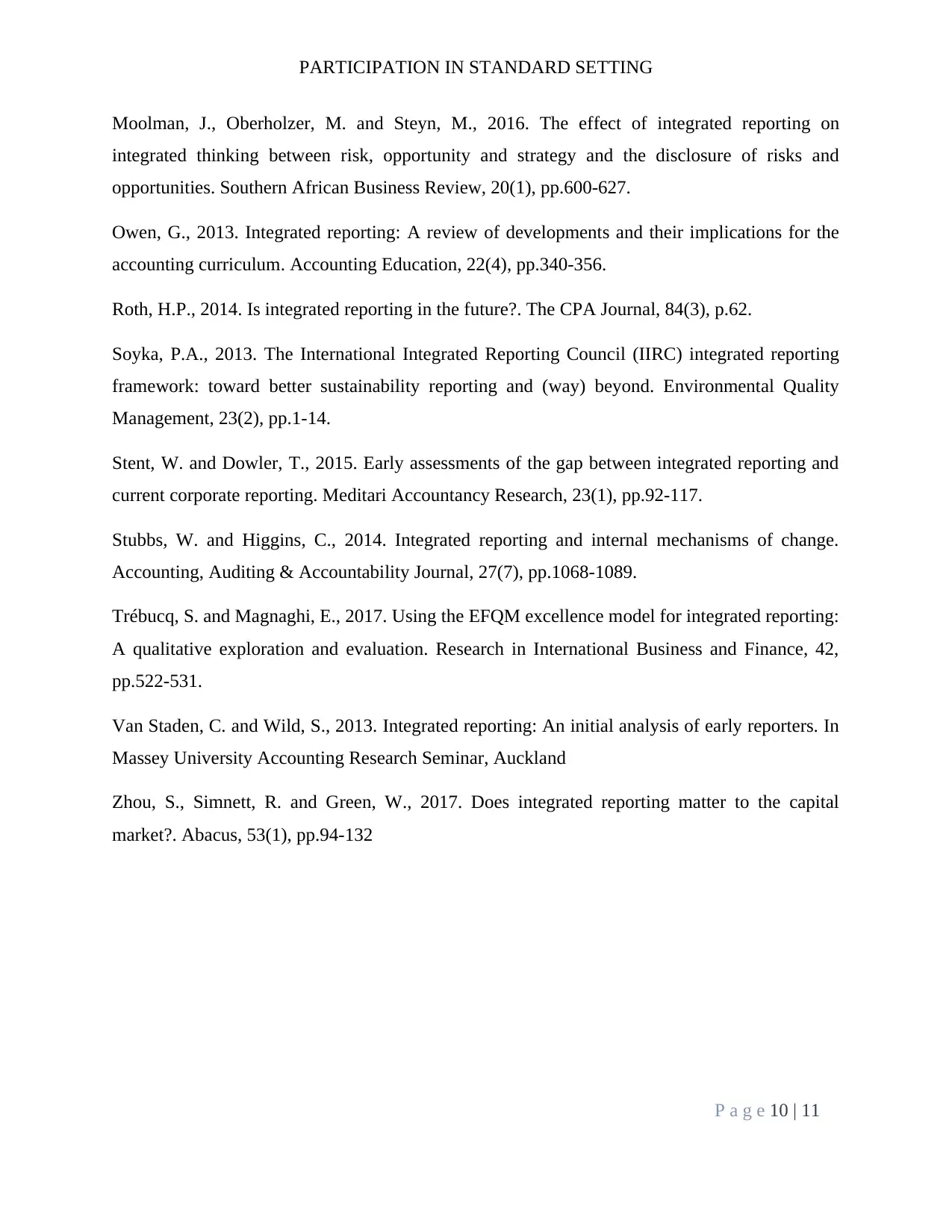
PARTICIPATION IN STANDARD SETTING
Moolman, J., Oberholzer, M. and Steyn, M., 2016. The effect of integrated reporting on
integrated thinking between risk, opportunity and strategy and the disclosure of risks and
opportunities. Southern African Business Review, 20(1), pp.600-627.
Owen, G., 2013. Integrated reporting: A review of developments and their implications for the
accounting curriculum. Accounting Education, 22(4), pp.340-356.
Roth, H.P., 2014. Is integrated reporting in the future?. The CPA Journal, 84(3), p.62.
Soyka, P.A., 2013. The International Integrated Reporting Council (IIRC) integrated reporting
framework: toward better sustainability reporting and (way) beyond. Environmental Quality
Management, 23(2), pp.1-14.
Stent, W. and Dowler, T., 2015. Early assessments of the gap between integrated reporting and
current corporate reporting. Meditari Accountancy Research, 23(1), pp.92-117.
Stubbs, W. and Higgins, C., 2014. Integrated reporting and internal mechanisms of change.
Accounting, Auditing & Accountability Journal, 27(7), pp.1068-1089.
Trébucq, S. and Magnaghi, E., 2017. Using the EFQM excellence model for integrated reporting:
A qualitative exploration and evaluation. Research in International Business and Finance, 42,
pp.522-531.
Van Staden, C. and Wild, S., 2013. Integrated reporting: An initial analysis of early reporters. In
Massey University Accounting Research Seminar, Auckland
Zhou, S., Simnett, R. and Green, W., 2017. Does integrated reporting matter to the capital
market?. Abacus, 53(1), pp.94-132
P a g e 10 | 11
Moolman, J., Oberholzer, M. and Steyn, M., 2016. The effect of integrated reporting on
integrated thinking between risk, opportunity and strategy and the disclosure of risks and
opportunities. Southern African Business Review, 20(1), pp.600-627.
Owen, G., 2013. Integrated reporting: A review of developments and their implications for the
accounting curriculum. Accounting Education, 22(4), pp.340-356.
Roth, H.P., 2014. Is integrated reporting in the future?. The CPA Journal, 84(3), p.62.
Soyka, P.A., 2013. The International Integrated Reporting Council (IIRC) integrated reporting
framework: toward better sustainability reporting and (way) beyond. Environmental Quality
Management, 23(2), pp.1-14.
Stent, W. and Dowler, T., 2015. Early assessments of the gap between integrated reporting and
current corporate reporting. Meditari Accountancy Research, 23(1), pp.92-117.
Stubbs, W. and Higgins, C., 2014. Integrated reporting and internal mechanisms of change.
Accounting, Auditing & Accountability Journal, 27(7), pp.1068-1089.
Trébucq, S. and Magnaghi, E., 2017. Using the EFQM excellence model for integrated reporting:
A qualitative exploration and evaluation. Research in International Business and Finance, 42,
pp.522-531.
Van Staden, C. and Wild, S., 2013. Integrated reporting: An initial analysis of early reporters. In
Massey University Accounting Research Seminar, Auckland
Zhou, S., Simnett, R. and Green, W., 2017. Does integrated reporting matter to the capital
market?. Abacus, 53(1), pp.94-132
P a g e 10 | 11
1 out of 11
Related Documents
Your All-in-One AI-Powered Toolkit for Academic Success.
+13062052269
info@desklib.com
Available 24*7 on WhatsApp / Email
![[object Object]](/_next/static/media/star-bottom.7253800d.svg)
Unlock your academic potential
Copyright © 2020–2025 A2Z Services. All Rights Reserved. Developed and managed by ZUCOL.




